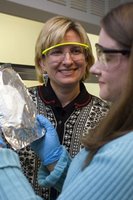CU biodegradable wipe would quickly detect biohazards, from avian flu to E. coli, By Susan Lang
 | Jamie Mullally '07, right, a Cornell Presidential Research Scholar, and Margaret Frey, assistant professor of textiles and apparel, examine a nonwoven nanofiber fabric on aluminum foil backing. |
Detecting bacteria, viruses and other dangerous substances in hospitals, airplanes and other commonly contaminated places could soon be as easy as wiping a napkin or paper towel across a surface
"It's very inexpensive, it wouldn't require that someone be highly trained to use it, and it could be activated for whatever you want to find," said Margaret Frey, the Lois and Mel Tukman Assistant Professor of Fiber Science and Apparel Design at Cornell University. "So if you're working in a meat-packing plant, for instance, you could swipe it across some hamburger and quickly and easily detect E. coli bacteria." She reported on the research Sept. 11 at the American Chemical Society's national meeting.
Once fully developed, the biodegradable absorbent wipe would contain nanofibers containing antibodies to numerous biohazards and chemicals and would signal by changing color or through another effect when the antibodies attached to their targets. Users would simply wipe the napkin across a surface; if a biohazard were detected, the surface could be disinfected and retested with another napkin to be sure it was no longer contaminated.
In work conducted with Yong Joo, assistant professor of chemical and biomolecular engineering, and Antje Baeumner, associate professor of biological and environmental engineering, both at Cornell, Frey developed nanofibers with platforms made of biotin, a part of the B vitamin complex, and the protein streptavidin, which can hold the antibodies. Composed of a polymer compound made from corn, the nanofibers could be incorporated into conventional paper products to keep costs low. Nanofibers, with diameters near 100 nanometers (a nanometer is one-billionth of a meter, or about three times the diameter of an atom), provide extremely large surface areas for sensing and increased absorbency compared with conventional fibers.
"The fabric basically acts as a sponge that you can use to dip in a liquid or wipe across a surface," Frey said. "The fabric itself will transport and concentrate the targeted biohazard. As you do that, antibodies in the fabric are going to selectively latch onto whatever pathogen that they match. Using this method we should, in theory, be able to quickly activate the fabric to detect whatever is the hazard of the week, whether it is bird flu, mad cow disease or anthrax."
Frey and her colleagues are still working on ways, such as a color change, for the fabric to signal that it has identified the contaminant.
"We're probably still a few years away from having this ready for the real world," Frey said, "but I really believe there is a place for this type of product that can be used by people with limited training to provide a fast indication of whether a biohazard is present."
This research was supported by the National Research Initiative of the U.S. Department of Agriculture's Cooperative State Research, Education and Extension Service.
### Contact: Blaine Friedlander bpf2@cornell.edu 607-254-8093 Cornell University News Service
Technorati Tags: nanofibers or Nanoscientists and Nano or Nanotechnology and nanoparticles or Nanotech and Biodegradable or nanochemistry and nanoscale or nanowires and Nanocantilevers or nanometrology and biohazards or Nanolight and nanostructures or Nanoscience
RELATED: Keywords Nanotech, science Friday, September 08, 2006 Nanoscientists Create Biological Switch from Spinach Molecule, Sunday, September 03, 2006 Sugar metabolism tracked in living plant tissues, in real time, Wednesday, August 30, 2006 'Nanocantilevers' yield surprises critical for designing new detectors, Sunday, August 27, 2006 ion pump cooling hot computer chips, Thursday, August 24, 2006 Honeycomb Network Comprised of Anthraquinone Molecules, Sunday, August 20, 2006 siRNA shrink ovarian cancer tumors, Wednesday, August 16, 2006 Nanotechnology














No comments:
Post a Comment